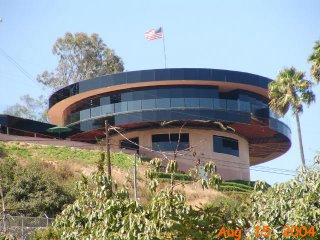Jim Lemke joined Howard, Mona and me for lunch at National University today and we had an enjoyable conversation about learning. I later found this letter posted on the net and thought I would share it here.
Date: 20 May 96
From: James Lemke
To: William Mahavier
Subject: Re: discovery
I think we are viewing the learning process the same way, but I can see where my last missive might have concerned you.
The finest formal learning process I ever experienced was after you and John accepted me and a few others as undergraduate students with the admonition that we were not to read any mathematic texts for two years. You stated plausible propositions, and if we accepted them, you told us to prove them. As we struggled with our "almost" proofs that were usually shot down by one of the other students finding a pathological set that blew it, you patiently stated ever-new propositions that were seemingly irrelevant at the time but which knit what we were doing into more sophisticated things to come. I'll never forget the thrill of reading Courant and Hilbert's Calculus when you released us to read. Some of the set proofs that I had created very clumsily were done in such elegance and apparent simplicity that it was stunning. I would not have appreciated the subtleties of their short proofs without having experienced every other possible way to tackle the proposition, myself.
The proofs we did in learning what turned out to be the Picard method of successive approximations were very illuminating for later work with differential equations.
Learning about the Stieltjes integral made it possible for me to accept the Dirac Delta function, which obviously couldn't exist, because I could get the same pick-out effect with the Stieltjes integral. What did bother me, though, was that none of my undergraduate physics teachers had even heard of the Stieltjes integral. The general tenor was, "If it's good enough for Dirac, it's good enough for you."
I seldom had similar learning experiences from others after you and John. Most of my physics teachers just shovelled out the facts and the derivations with almost no perspective or attempt at heuristic approaches. Doing the assigned problems, but more importantly, doing additional problems that the problems themselves suggested, was where I learned physics.
You mentioned the physics lab as a directed discovery. If you mean the school lab, I couldn't disagree more. I hated all of the physics labs. They were canned experiments of known and expected results and were terribly sterile.
I was forced to teach an optics lab one year over my strenuous objections, but I got the concession that I could teach it my way. I told the students that were going to design the experiment themselves. I gave each one a different lens from the physics storeroom. Their task was to measure everything there was to know about that lens; index, nodal planes, focal length, distortions, spectral effect on the other properties, diffraction limit, etc. I then lectured during half of the lab time about experimental design techniques and had office hours daily to help them in the designs. I was amazed and very pleased how some of them caught fire and proposed some very clever experiments. After a while, everybody got into it and had a good time.
The best learning experiences I had in physics prior to the qualifier were while doing homework problems. There were some brilliant lectures that literally stunned me such as the first time I realized that the special theory of relativity was a natural consequence of accepting the Michelson-Morley experiment as correct and asking what were the consequences of that assumption--the main results just fell out. But it wasn't until many problems later that I felt I had started to understand some of the implications of that very simple theory. The principle was simply stated, "Accept the experimental facts, even if implausible, and see what the consequences are." Owning he results took a lot of private study.
How much better that experience could have been if the results had not been stated but, rather, the problem assigned to explore the seemingly impossible M-M results by assuming that the speed of light is the same in any inertial frame of reference and let us explore the consequences. Would we have found E=mc2 ourselves?
One of my graduate professors, Max Dresden, was a great lecturer because, like Pauling, he always stepped back and asked what did all of the formalism mean. I took a seminar from him on magnetism and we spent two days going through the Anderson theory of antiferromagnetism where the spins are anti-aligned through interaction with the oxygen atom. After great angst, sure enough, the wave functions inverted at the second 3-d site and antiferromagnetism resulted. He then said, "Now I'll show you how Linus Pauling gets the same results in about four lines using the Pauli Exclusion Principle, but, of course, we don't do it that way in theoretical physics to keep the shoe clerks out of the business."
I guess what I was trying to say was that the method you and John used on us, and I assumed it was the Moore method, is applicable to many disciplines, but I rarely encountered it again after IIT. All of my learning I did myself (that may be the only way one can learn) but I never got any spark from my teachers until graduate research time. My advisor, Hal Lewis, accepted a problem I proposed after discussing it with Elliot Montroll. He then met with me when I wanted to talk things over. I remember him asking me if I was aware of the Bethe-Peierls-Weiss approximation--I wasn't. When I looked into it, it suggested several very fruitful avenues. That was good mentoring.
I'm still very active theoretically and experimentally and get a big kick out of learning something new. It's a lot of fun to tackle problems that have been around for a long time with new insights and get valuable results. I owe a lot of that ability to you and John; I certainly didn't get it from most of my physics teachers.
My apologies for this long note. Hope all is well with you and Jean. Any motorcycle adventures planned for this summer? Ann and I will be going to Munich mid June for some business on one of my patents, and then on to Salzburg, Linz, Vienna, Budapest, Prague, and maybe Warsaw. All by train and foot. We'll be in Montana after July 18th--same email address.
Cheers
Jim & Ann




